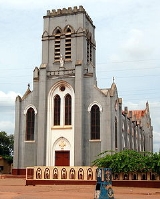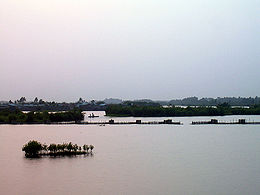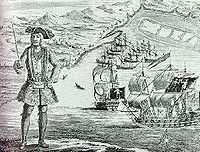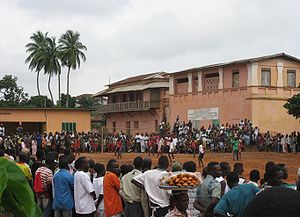
Ouidah
Encyclopedia
Ouidah also Whydah ˈ or Juda, is a city on the Atlantic
coast of Benin
.
The commune covers an area of 364 square kilometres and as of 2002 had a population of 76,555 people.
In 1727 the Kingdom of Whydah
was captured by the forces of King Agaja of Dahomey.
The Portuguese, English
and French
all constructed forts in the city to protect their interests in slaving. The Portuguese
reached the town they called Ajudá in 1580 and the Portuguese Fort of São João Baptista de Ajudá, now housing a museum
, dates from 1721 and remained with Portugal until 31 July 1961.
 Other attractions in Ouidah include a restored mansion of Brazilian slavers the Maison du Brésil art gallery
Other attractions in Ouidah include a restored mansion of Brazilian slavers the Maison du Brésil art gallery
, a voodoo python temple
, an early twentieth century basilica
and the Sacred Forest of Kpasse, dotted with bronze
statue
s.
The Route des Esclaves, by which slave
s were taken to the beach
, has numerous statues and monument
s, including the Door of No Return, a monumental arch.
The Market Center of Ouidah, which was established by Scouts
more than 20 years ago, trains young people in agricultural skills, thus helping to reverse the exodus towards the cities.
Ouidah is the spiritual capital of the Vodun religion, and hosts an annual international Vodun conference.
St. John the Baptist of Ouidah Fort) is a small fortress built by the Portuguese
in the city of Ouidah on the coast of Dahomey
(originally Ajudá, from Hweda, on the Atlantic coast of modern Benin
), reached by the Portuguese in 1580, after which it grew around the slave trade, for which the Slave Coast
was already renowned. The Fort, built in land given to Portugal
by the King of Dahomey, remained under Portuguese control from 1721 until 1961.
In 1680 the Portuguese governor of São Tomé and Príncipe
was authorised to erect a fort. In 1721, after having been abandoned for some years, it was reconstructed and named São João Baptista de Ajudá.
 The fort had an important impact in Benin
The fort had an important impact in Benin
, greatly contributing to both the Portuguese and African slave trade
. Its importance is attested by the fact that the Portuguese language
was the only foreign language that the Kings of Dahomey
authorised. Portuguese descendants were also important in the political structure of the kingdom and some established Portuguese
-Brazil
ian families, such as the Sousa
whose descendants still exist in Benin, were powerful and abided by private law. In January 1722 the pirate Bartholomew Roberts
("Black Bart") sailed into the harbour and captured all the eleven ships at anchor there.
Following the abolition of the legal slave trade in 1807, the fort, which had before been one of the major slave ports, gradually lost its importance and although Portugal continued to claim it as one of its possessions, formal occupation and administration were abandoned on several occasions. It was only when French
presence in the region started threatening Portugal’s interests that the settlement was again permanently manned. This didn't prevent the French conquest of Dahomey
(1891–1894). After this, São João Baptista de Ajudá - now reduced to the territory actually within the walls of the fort - lost what remained of its importance.
 The fort was reoccupied by Portugal in 1865. In this period it served as a base for a brief Portuguese attempt to create a protectorate
The fort was reoccupied by Portugal in 1865. In this period it served as a base for a brief Portuguese attempt to create a protectorate
in the Kingdom of Dahomey of which the city of Hweda (Ajudá - Ouidah) was part (1885–1887).
Until its annexation
by Dahomey in 1961, São João Baptista de Ajudá was probably the smallest recognized separate modern political unit: according to the census of 1921 it had 5 inhabitants and, at the moment of the ultimatum by the Dahomey Government, it had only 2 inhabitants representing Portuguese Sovereignty who tried to burn it rather than surrendering it.
Only in 1975, after the Portuguese Estado Novo regime has been overthrown due to the Carnation Revolution
at Lisbon
, did the annexation of the fort by Dahomey
(now renamed Benin
) gain official Portuguese recognition. This was followed by the forts' restoration, which was paid for by Portugal. The fort is a small square with towers at the four corners. It comprises a church and officers' quarters. The Fort of São João Baptista de Ajudá now houses a museum
.
Bruce Chatwin
’s book The Viceroy of Ouidah
(1980) is a fictional retelling of the life of Francisco Félix de Sousa, the Sousa family founder in Benin and that of his powerful local descendants, dealing also with the subject of slave trade with Brazil
.

World Heritage Tentative List on October 31, 1996 in the Cultural category.
Atlantic Ocean
The Atlantic Ocean is the second-largest of the world's oceanic divisions. With a total area of about , it covers approximately 20% of the Earth's surface and about 26% of its water surface area...
coast of Benin
Benin
Benin , officially the Republic of Benin, is a country in West Africa. It borders Togo to the west, Nigeria to the east and Burkina Faso and Niger to the north. Its small southern coastline on the Bight of Benin is where a majority of the population is located...
.
The commune covers an area of 364 square kilometres and as of 2002 had a population of 76,555 people.
History
In local tradition Kpase is supposed to have founded the town. This probably happened towards the end of the sixteenth century. The town was originally known as Glēxwé, literally 'Farmhouse', and was part of the kingdom of Xwéda.In 1727 the Kingdom of Whydah
Kingdom of Whydah
The Kingdom of Whydah , sometimes written Hueda, was a kingdom on the coast of West Africa in the boundaries of the modern nation of Benin. Between 1677 and 1681 it was conquered by the Akwamu a member of the Akan people. It was a major slave trading post...
was captured by the forces of King Agaja of Dahomey.
The Portuguese, English
English colonial empire
The English colonial empire consisted of a variety of overseas territories colonized, conquered, or otherwise acquired by the former Kingdom of England between the late 16th and early 18th centuries....
and French
France
The French Republic , The French Republic , The French Republic , (commonly known as France , is a unitary semi-presidential republic in Western Europe with several overseas territories and islands located on other continents and in the Indian, Pacific, and Atlantic oceans. Metropolitan France...
all constructed forts in the city to protect their interests in slaving. The Portuguese
Portugal
Portugal , officially the Portuguese Republic is a country situated in southwestern Europe on the Iberian Peninsula. Portugal is the westernmost country of Europe, and is bordered by the Atlantic Ocean to the West and South and by Spain to the North and East. The Atlantic archipelagos of the...
reached the town they called Ajudá in 1580 and the Portuguese Fort of São João Baptista de Ajudá, now housing a museum
Museum
A museum is an institution that cares for a collection of artifacts and other objects of scientific, artistic, cultural, or historical importance and makes them available for public viewing through exhibits that may be permanent or temporary. Most large museums are located in major cities...
, dates from 1721 and remained with Portugal until 31 July 1961.

Art gallery
An art gallery or art museum is a building or space for the exhibition of art, usually visual art.Museums can be public or private, but what distinguishes a museum is the ownership of a collection...
, a voodoo python temple
Temple
A temple is a structure reserved for religious or spiritual activities, such as prayer and sacrifice, or analogous rites. A templum constituted a sacred precinct as defined by a priest, or augur. It has the same root as the word "template," a plan in preparation of the building that was marked out...
, an early twentieth century basilica
Basilica
The Latin word basilica , was originally used to describe a Roman public building, usually located in the forum of a Roman town. Public basilicas began to appear in Hellenistic cities in the 2nd century BC.The term was also applied to buildings used for religious purposes...
and the Sacred Forest of Kpasse, dotted with bronze
Bronze
Bronze is a metal alloy consisting primarily of copper, usually with tin as the main additive. It is hard and brittle, and it was particularly significant in antiquity, so much so that the Bronze Age was named after the metal...
statue
Statue
A statue is a sculpture in the round representing a person or persons, an animal, an idea or an event, normally full-length, as opposed to a bust, and at least close to life-size, or larger...
s.
The Route des Esclaves, by which slave
Slavery
Slavery is a system under which people are treated as property to be bought and sold, and are forced to work. Slaves can be held against their will from the time of their capture, purchase or birth, and deprived of the right to leave, to refuse to work, or to demand compensation...
s were taken to the beach
Beach
A beach is a geological landform along the shoreline of an ocean, sea, lake or river. It usually consists of loose particles which are often composed of rock, such as sand, gravel, shingle, pebbles or cobblestones...
, has numerous statues and monument
Monument
A monument is a type of structure either explicitly created to commemorate a person or important event or which has become important to a social group as a part of their remembrance of historic times or cultural heritage, or simply as an example of historic architecture...
s, including the Door of No Return, a monumental arch.
The Market Center of Ouidah, which was established by Scouts
Scoutisme Béninois
Scoutisme Béninois is the national Scouting organization of Benin Scouting in Benin started around 1930 and became a member of the World Organization of the Scout Movement in 1964 under the previous name Dahomey...
more than 20 years ago, trains young people in agricultural skills, thus helping to reverse the exodus towards the cities.
Ouidah is the spiritual capital of the Vodun religion, and hosts an annual international Vodun conference.
Demographics
The population evolution of Ouidah is as follows:| Year | Population |
|---|---|
| 1979 | 25 459 |
| 1992 | 64 433 |
| 2002 | 77 832 |
| 2008 (estimate) | 90 042 |
Fort of São João Baptista de Ajudá
The Fort of São João Baptista de Ajudá (in EnglishEnglish language
English is a West Germanic language that arose in the Anglo-Saxon kingdoms of England and spread into what was to become south-east Scotland under the influence of the Anglian medieval kingdom of Northumbria...
St. John the Baptist of Ouidah Fort) is a small fortress built by the Portuguese
Portugal
Portugal , officially the Portuguese Republic is a country situated in southwestern Europe on the Iberian Peninsula. Portugal is the westernmost country of Europe, and is bordered by the Atlantic Ocean to the West and South and by Spain to the North and East. The Atlantic archipelagos of the...
in the city of Ouidah on the coast of Dahomey
Dahomey
Dahomey was a country in west Africa in what is now the Republic of Benin. The Kingdom of Dahomey was a powerful west African state that was founded in the seventeenth century and survived until 1894. From 1894 until 1960 Dahomey was a part of French West Africa. The independent Republic of Dahomey...
(originally Ajudá, from Hweda, on the Atlantic coast of modern Benin
Benin
Benin , officially the Republic of Benin, is a country in West Africa. It borders Togo to the west, Nigeria to the east and Burkina Faso and Niger to the north. Its small southern coastline on the Bight of Benin is where a majority of the population is located...
), reached by the Portuguese in 1580, after which it grew around the slave trade, for which the Slave Coast
Slave Coast
The Slave Coast is the name of the coastal areas of present Togo, Benin and western Nigeria, a fertile region of coastal Western Africa along the Bight of Benin. In pre-colonial time it was one of the most densely populated parts of the African continent...
was already renowned. The Fort, built in land given to Portugal
Portugal
Portugal , officially the Portuguese Republic is a country situated in southwestern Europe on the Iberian Peninsula. Portugal is the westernmost country of Europe, and is bordered by the Atlantic Ocean to the West and South and by Spain to the North and East. The Atlantic archipelagos of the...
by the King of Dahomey, remained under Portuguese control from 1721 until 1961.
In 1680 the Portuguese governor of São Tomé and Príncipe
São Tomé and Príncipe
São Tomé and Príncipe, officially the Democratic Republic of São Tomé and Príncipe, is a Portuguese-speaking island nation in the Gulf of Guinea, off the western equatorial coast of Central Africa. It consists of two islands: São Tomé and Príncipe, located about apart and about , respectively, off...
was authorised to erect a fort. In 1721, after having been abandoned for some years, it was reconstructed and named São João Baptista de Ajudá.

Benin
Benin , officially the Republic of Benin, is a country in West Africa. It borders Togo to the west, Nigeria to the east and Burkina Faso and Niger to the north. Its small southern coastline on the Bight of Benin is where a majority of the population is located...
, greatly contributing to both the Portuguese and African slave trade
African slave trade
Systems of servitude and slavery were common in many parts of Africa, as they were in much of the ancient world. In some African societies, the enslaved people were also indentured servants and fully integrated; in others, they were treated much worse...
. Its importance is attested by the fact that the Portuguese language
Portuguese language
Portuguese is a Romance language that arose in the medieval Kingdom of Galicia, nowadays Galicia and Northern Portugal. The southern part of the Kingdom of Galicia became independent as the County of Portugal in 1095...
was the only foreign language that the Kings of Dahomey
Dahomey
Dahomey was a country in west Africa in what is now the Republic of Benin. The Kingdom of Dahomey was a powerful west African state that was founded in the seventeenth century and survived until 1894. From 1894 until 1960 Dahomey was a part of French West Africa. The independent Republic of Dahomey...
authorised. Portuguese descendants were also important in the political structure of the kingdom and some established Portuguese
Portugal
Portugal , officially the Portuguese Republic is a country situated in southwestern Europe on the Iberian Peninsula. Portugal is the westernmost country of Europe, and is bordered by the Atlantic Ocean to the West and South and by Spain to the North and East. The Atlantic archipelagos of the...
-Brazil
Brazil
Brazil , officially the Federative Republic of Brazil , is the largest country in South America. It is the world's fifth largest country, both by geographical area and by population with over 192 million people...
ian families, such as the Sousa
Sousa
-Surname:*Sousa *John Philip Sousa, American bandleader and composer, writer of America's national march*Francis Newton Souza, Indian artist and founding member of the Progressive Artists' Group of Bombay...
whose descendants still exist in Benin, were powerful and abided by private law. In January 1722 the pirate Bartholomew Roberts
Bartholomew Roberts
Bartholomew Roberts , born John Roberts, was a Welsh pirate who raided ships off America and West Africa between 1719 and 1722. He was the most successful pirate of the Golden Age of Piracy. He is estimated to have captured over 470 vessels...
("Black Bart") sailed into the harbour and captured all the eleven ships at anchor there.
Following the abolition of the legal slave trade in 1807, the fort, which had before been one of the major slave ports, gradually lost its importance and although Portugal continued to claim it as one of its possessions, formal occupation and administration were abandoned on several occasions. It was only when French
France
The French Republic , The French Republic , The French Republic , (commonly known as France , is a unitary semi-presidential republic in Western Europe with several overseas territories and islands located on other continents and in the Indian, Pacific, and Atlantic oceans. Metropolitan France...
presence in the region started threatening Portugal’s interests that the settlement was again permanently manned. This didn't prevent the French conquest of Dahomey
Dahomey
Dahomey was a country in west Africa in what is now the Republic of Benin. The Kingdom of Dahomey was a powerful west African state that was founded in the seventeenth century and survived until 1894. From 1894 until 1960 Dahomey was a part of French West Africa. The independent Republic of Dahomey...
(1891–1894). After this, São João Baptista de Ajudá - now reduced to the territory actually within the walls of the fort - lost what remained of its importance.

Protectorate
In history, the term protectorate has two different meanings. In its earliest inception, which has been adopted by modern international law, it is an autonomous territory that is protected diplomatically or militarily against third parties by a stronger state or entity...
in the Kingdom of Dahomey of which the city of Hweda (Ajudá - Ouidah) was part (1885–1887).
Until its annexation
Annexation
Annexation is the de jure incorporation of some territory into another geo-political entity . Usually, it is implied that the territory and population being annexed is the smaller, more peripheral, and weaker of the two merging entities, barring physical size...
by Dahomey in 1961, São João Baptista de Ajudá was probably the smallest recognized separate modern political unit: according to the census of 1921 it had 5 inhabitants and, at the moment of the ultimatum by the Dahomey Government, it had only 2 inhabitants representing Portuguese Sovereignty who tried to burn it rather than surrendering it.
Only in 1975, after the Portuguese Estado Novo regime has been overthrown due to the Carnation Revolution
Carnation Revolution
The Carnation Revolution , also referred to as the 25 de Abril , was a military coup started on 25 April 1974, in Lisbon, Portugal, coupled with an unanticipated and extensive campaign of civil resistance...
at Lisbon
Lisbon
Lisbon is the capital city and largest city of Portugal with a population of 545,245 within its administrative limits on a land area of . The urban area of Lisbon extends beyond the administrative city limits with a population of 3 million on an area of , making it the 9th most populous urban...
, did the annexation of the fort by Dahomey
Dahomey
Dahomey was a country in west Africa in what is now the Republic of Benin. The Kingdom of Dahomey was a powerful west African state that was founded in the seventeenth century and survived until 1894. From 1894 until 1960 Dahomey was a part of French West Africa. The independent Republic of Dahomey...
(now renamed Benin
Benin
Benin , officially the Republic of Benin, is a country in West Africa. It borders Togo to the west, Nigeria to the east and Burkina Faso and Niger to the north. Its small southern coastline on the Bight of Benin is where a majority of the population is located...
) gain official Portuguese recognition. This was followed by the forts' restoration, which was paid for by Portugal. The fort is a small square with towers at the four corners. It comprises a church and officers' quarters. The Fort of São João Baptista de Ajudá now houses a museum
Museum
A museum is an institution that cares for a collection of artifacts and other objects of scientific, artistic, cultural, or historical importance and makes them available for public viewing through exhibits that may be permanent or temporary. Most large museums are located in major cities...
.
Bruce Chatwin
Bruce Chatwin
Charles Bruce Chatwin was an English novelist and travel writer. He won the James Tait Black Memorial Prize for his novel On the Black Hill...
’s book The Viceroy of Ouidah
The Viceroy of Ouidah
-Summary:Chatwin's novel, detailing the life of a slave trader named Francisco Manuel da Silva, is loosely based on the life of an historical Brazilian, Francisco Felix de Sousa, who became a powerful personage in Wydah or Ouidah, the so-called Slave Coast of West Africa, now Benin and Togo...
(1980) is a fictional retelling of the life of Francisco Félix de Sousa, the Sousa family founder in Benin and that of his powerful local descendants, dealing also with the subject of slave trade with Brazil
Brazil
Brazil , officially the Federative Republic of Brazil , is the largest country in South America. It is the world's fifth largest country, both by geographical area and by population with over 192 million people...
.
Notable landmarks

- Door of No Return
- Ouidah Cathedral
- Basilique de l’Immaculée ConceptionBasilique de l’Immaculée ConceptionThe ' is a Roman Catholic minor basilica dedicated to the Immaculate Conception located in Ouidah, Benin. The basilica is under the circumscription of the Archdiocese of Cotonou. The basilica was dedicated on November 9, 1989.-References:**...
World Heritage Status
This site was added to the UNESCOUNESCO
The United Nations Educational, Scientific and Cultural Organization is a specialized agency of the United Nations...
World Heritage Tentative List on October 31, 1996 in the Cultural category.
See also
- Heads of State of BeninHeads of state of Benin-Presidents of Benin :-Affiliations:-Latest election:-Sources:*http://www.rulers.org/rulb1.html#benin*http://www.worldstatesmen.org/Benin.html*http://news.bbc.co.uk/...
- Heads of Government of BeninHeads of government of Benin-Prime Ministers of Benin :-Affiliations:-Sources:*http://www.rulers.org/rulb1.html#benin*http://www.worldstatesmen.org/Benin.html*http://news.bbc.co.uk/...

